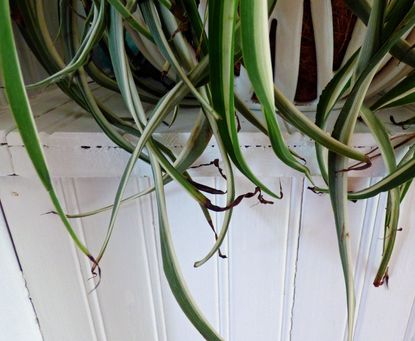Why Your Spider Plant Has Brown Tips & How To Fix It
When your favorite spider plant tips are brown you can assume it needs something different. Check on its care needs if you see brown spider plant leaves.


WHY YOUR SPIDER PLANT TIPS ARE BROWN & HOW TO FIX THEM
When your spider plant has brown tips it is trying to tell you something. One of the most classic houseplants, spider plants are relatively trouble-free with few special needs. So when spider plant tips are brown, the most likely causes are cultural and environmental. Spider plants are native to South Africa where the climate is subtropical to temperate and heavily influenced by the ocean. They require conditions similar to those they would enjoy in their wild environment.
Common Causes of a Spider Plant with Brown Tips
Spider plants are popular for their ease of care and for their delightful plantlets, which cascade down from the core plant. Many owners of the plant have asked us, “Why are the tips of my spider plant brown? “ So we know brown spider plant leaves are a very common occurrence and can be the result of several issues. The type of water used, the amount of humidity, scorching sun exposure, and other items can contribute when spider plant tips turn brown.
Too Much Water
The thick rhizomes will store water for the plant’s use in its home range. Overall, they have medium water needs but every plant will be different as dictated by the home conditions. The general rule of thumb is to water the plant when the top 2 inches ( 5 cm.) of soil are dry to the touch. Water the plant until the moisture comes out the drainage holes. This thorough saturation will allow excess salts to leach out.
Not Enough Water
While too much water can cause brown spider plant leaves, it can also occur due to insufficient water. Spider plant leaves turning brown could be a response to excessively dry soil and rhizomes which are not sufficiently full. If the plant is kept on the dry side consistently, it will protest by having the terminal ends dry and discolor. If you are in doubt about the amount of water, use a soil meter to monitor the plant’s moisture levels.
Too Much Fertilizer
Gardening tips, videos, info and more delivered right to your inbox!
Sign up for the Gardening Know How newsletter today and receive a free download of our most popular eBook "How to Grow Delicious Tomatoes."
The rhizomes not only store moisture but carbohydrates. In the case of most plants that are housed in good potting soil and that is changed every year or 2, the plant will not need much fertilizer. In fact, too much feeding and it will fail to form plantlets. Only feed the plant during active growth, spring to early fall. Use a balanced liquid food that is diluted by half just once every 3-4 months. If a time release formula is used, apply half the recommended amount once per season.
Too Much Sun
These plants often grow as understory plants where the canopy will provide protection from hot, bright sunlight. In the home, situate the plant away from bright windows. Plants in southern or western windows may see the leaf ends brown as they scorch. The best light will be partial to full shade with diluted light. Spider plants are ideal for sites with only artificial light such as office buildings.
Low Humidity
Chlorophytum comosum thrives in higher humidity. In the winter, when heaters are turned on, they may need supplemental ambient moisture. Mist the plant daily or place the container on a saucer filled with small stones and water. This will evaporate around the plant, enhancing the humidity.
Chemical Buildup
Spider plants are very sensitive to chemicals. They are also very good at cleaning the air. Houseplants that are watered with tap water can suffer from certain chemicals. Every municipality has a different water composition. Fluoride is a very common tap water additive and can cause leaf burning in many types of plants. If you are in doubt about yours, water the plant with rainwater or purchased water. It can also help to let the water sit out for several hours or overnight to offgas.
Diseases
Root rot is the most common problem in spider plants. Insufficient drainage, heavy soil, and overwatering can contribute to unhappy rhizomes and roots. If they are sitting in constant moisture, fungal diseases may flourish. Allow the plant to dry a bit before watering and make sure the drainage holes are open and operational.
How to Fix a Spider Plant With Brown Tips
While spider plants don’t ask a lot of us, they do need indirect light, moderate water, at least one annual feeding, and medium humidity. Many growers simply cut the unsightly tips off the plant, but since the browning is a symptom of something, consider the cultivation techniques you are using. Assess the plant’s environment and consider changing it, or even repotting the plant if there are root or rhizome problems. Overwatering, excess light, and overfeeding are easy to fix.
FREQUENTLY ASKED QUESTIONS
Should I Cut the Brown Tips Off My Spider Plant?
As mentioned, it is very common to simply cut off the leaf tips. This improves the appearance of the plant and won’t hurt it, provided only a bit is removed.
How Often Should You Water a Spider Plant?
Plants that grow in different regions will have different water needs. Additionally, home interiors will vary greatly by type of heat, duration, and intensity of the seasons, average light, and many more factors. The simple hand test will tell you when the plant is thirsty. Check the soil every few days to get an average gauge.

Bonnie Grant is a professional landscaper with a Certification in Urban Gardening. She has been gardening and writing for 15 years. A former professional chef, she has a passion for edible landscaping.
-
 "My Worst Mistake" – Gardeners Share 10 Hard-Learned Lessons
"My Worst Mistake" – Gardeners Share 10 Hard-Learned LessonsGardeners never stop learning, and sometimes our mistakes are the best teachers. But why not save time and heartache by learning from other gardeners' failures?
By Melanie Griffiths
-
 Crops for Urban Growing: 8 Edible Plants For Urban Gardens
Crops for Urban Growing: 8 Edible Plants For Urban GardensUrban edible gardening lets your yard do double duty of beauty and practicality. Have fun combining edible plants with ornamentals.
By Teo Spengler